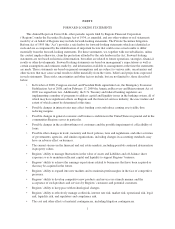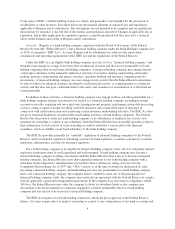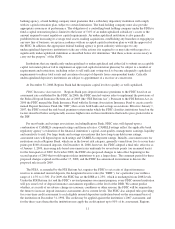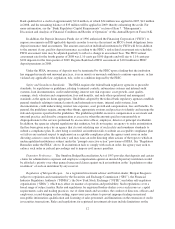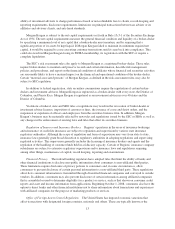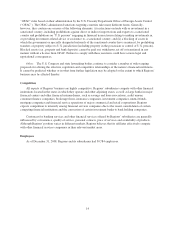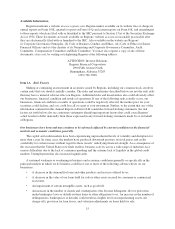Regions Bank 2008 Annual Report Download - page 17
Download and view the complete annual report
Please find page 17 of the 2008 Regions Bank annual report below. You can navigate through the pages in the report by either clicking on the pages listed below, or by using the keyword search tool below to find specific information within the annual report.(iii) a new public-private investment fund that will leverage public and private capital with public financing to
purchase up to $500 billion to $1 trillion of legacy “toxic assets” from financial institutions, and (iv) assistance
for homeowners by providing up to $75 billion to reduce mortgage payments and interest rates and establishing
loan modification guidelines for government and private programs. In addition, all banking institutions with
assets over $100 billion, such as Regions, will be required to undergo a comprehensive “stress test” to determine
if they have sufficient capital to continue lending and to absorb losses that could result from a more severe
decline in the economy than projected.
Institutions receiving assistance under the Financial Stability Plan going forward will be subject to higher
transparency and accountability standards, including restrictions on dividends, acquisitions and executive
compensation and additional disclosure requirements. Regions cannot predict at this time the effect that the
Financial Stability Plan may have on it or its business, financial condition or results of operations.
Payment of Dividends. Regions is a legal entity separate and distinct from its banking and other
subsidiaries. The principal source of cash flow of Regions, including cash flow to pay dividends to its
stockholders and principal and interest on any debt of Regions, is dividends from Regions Bank. There are
statutory and regulatory limitations on the payment of dividends by Regions Bank to Regions, as well as by
Regions to its stockholders.
As to the payment of dividends, Regions Bank is subject to the laws and regulations of the state of Alabama
and to the regulations of the Federal Reserve. The payment of dividends by Regions and Regions Bank may also
be affected or limited by other factors, such as the requirement to maintain adequate capital above regulatory
guidelines.
If, in the opinion of a federal regulatory agency, an institution under its jurisdiction is engaged in or is about
to engage in an unsafe or unsound practice (which, depending on the financial condition of the institution, could
include the payment of dividends), such agency may require, after notice and hearing, that such institution cease
and desist from such practice. The federal banking agencies have indicated that paying dividends that deplete an
institution’s capital base to an inadequate level would be an unsafe and unsound banking practice. Under the
Federal Deposit Insurance Act (“FDIA”), an insured institution may not pay any dividend if payment would
cause it to become “undercapitalized” or if it already is “undercapitalized.” See “Regulatory Remedies under the
FDIA” below. Moreover, the Federal Reserve and the FDIC have issued policy statements stating that bank
holding companies and insured banks should generally pay dividends only out of current operating earnings.
Under the Federal Reserve’s Regulation H, Regions Bank may not, without the approval of the Federal
Reserve, declare or pay a dividend to Regions if the total of all dividends declared in a calendar year exceeds the
total of (a) Regions Bank’s net income for that year and (b) its retained net income for the preceding two
calendar years, less any required transfers to additional paid-in capital or to a fund for the retirement of preferred
stock. As a result of our $5.6 billion loss in 2008, Regions Bank cannot, without approval from the Federal
Reserve, declare or pay a dividend to Regions until such time as Regions Bank is able to satisfy the criteria
discussed in the preceding sentence. Given the loss in 2008, Regions Bank does not expect to be able to pay
dividends to Regions in the near term without obtaining regulatory approval. Under Alabama law, a bank may
not pay a dividend in excess of 90 percent of its net earnings until the bank’s surplus is equal to at least 20
percent of capital. Regions Bank is also required by Alabama law to obtain approval of the Superintendent of
Banking prior to the payment of dividends if the total of all dividends declared by Regions Bank in any calendar
year will exceed the total of (a) Regions Bank’s net earnings (as defined by statute) for that year, plus (b) its
retained net earnings for the preceding two years, less any required transfers to surplus. Also, no dividends may
be paid from Regions Bank’s surplus without the prior written approval of the Superintendent of Banking.
However, the ability of Regions to pay dividends to its stockholders is not totally dependent on the receipt
of dividends from Regions Bank, as Regions has other cash available to make such payment. As of December 31,
2008, Regions had $4.8 billion of cash and cash equivalents, which is available for corporate purposes, including
7






